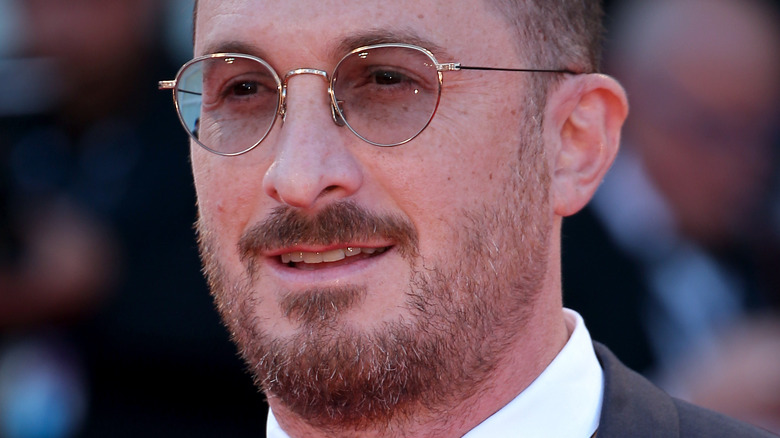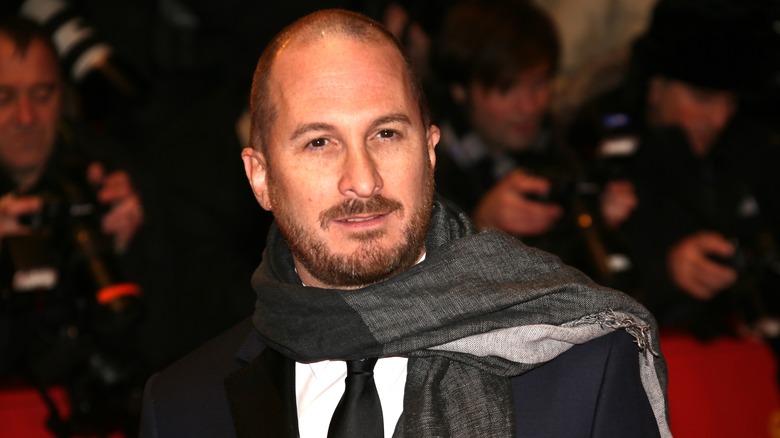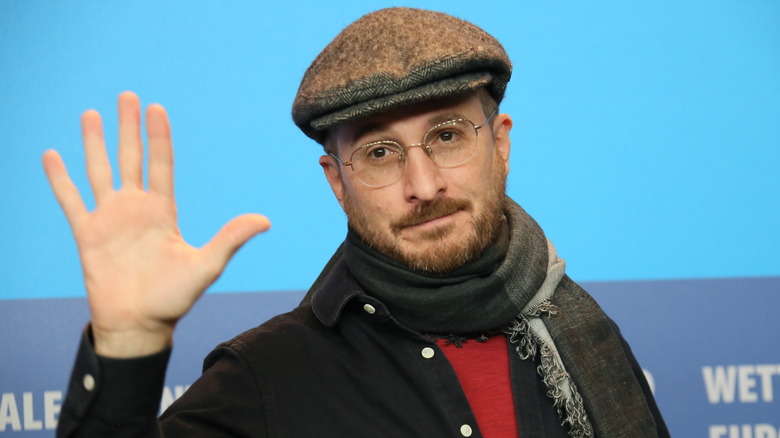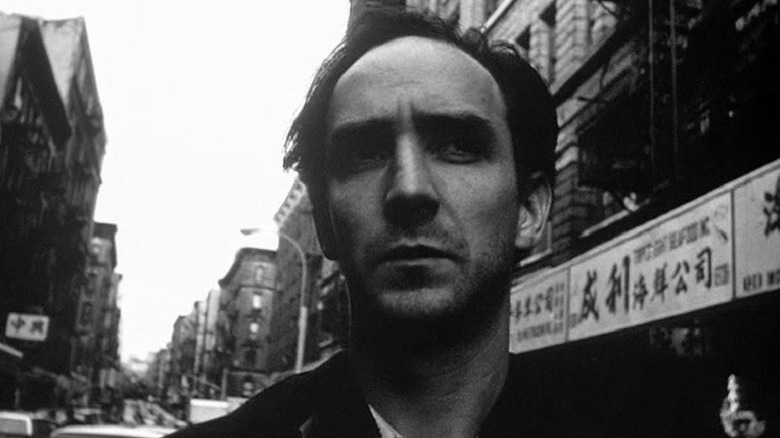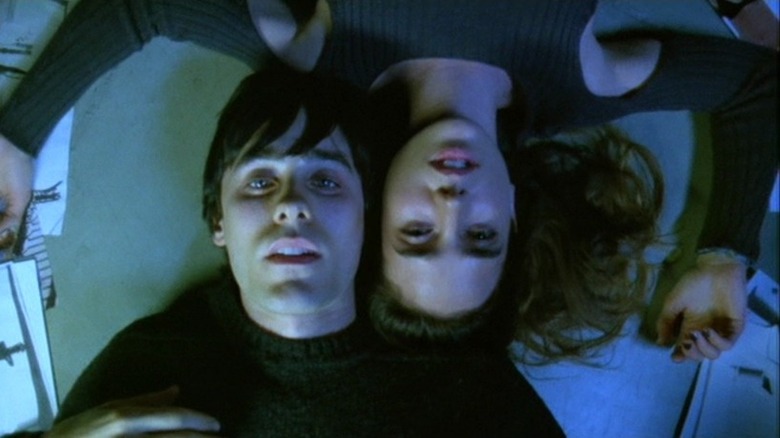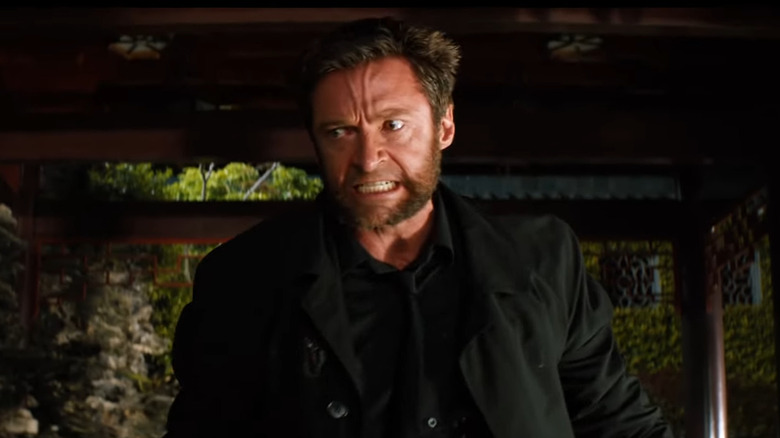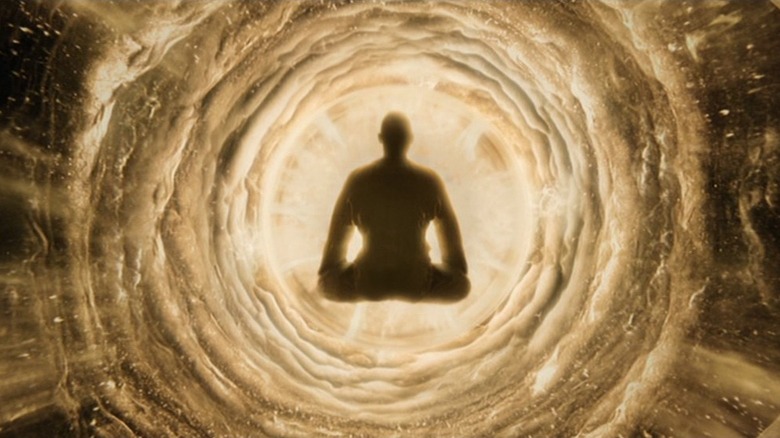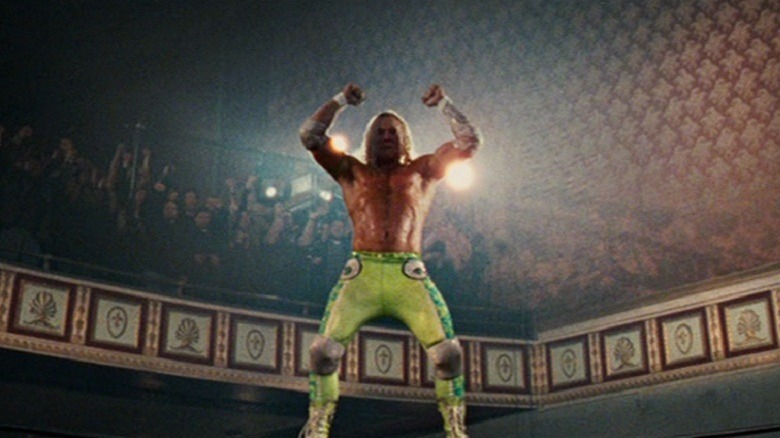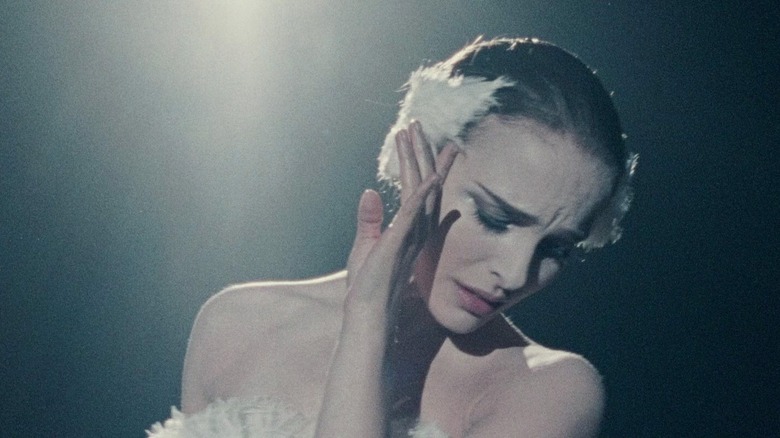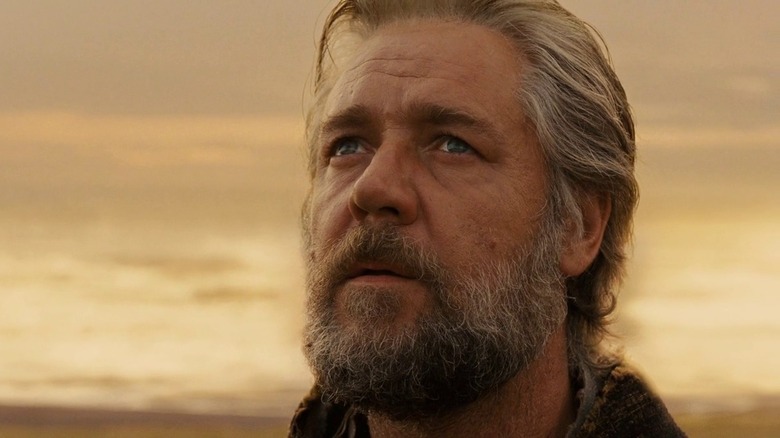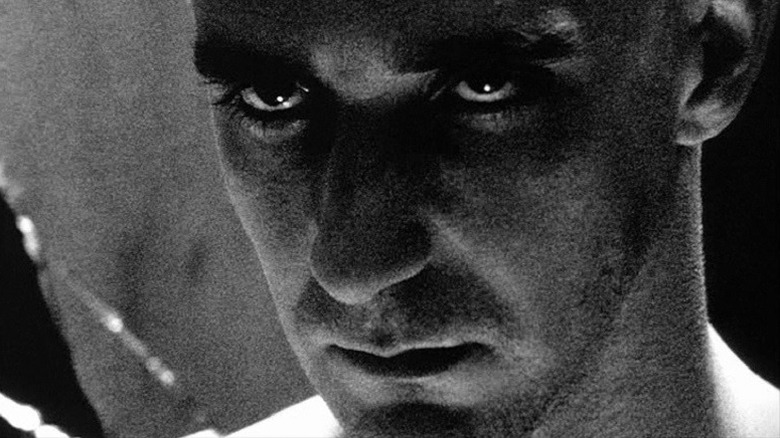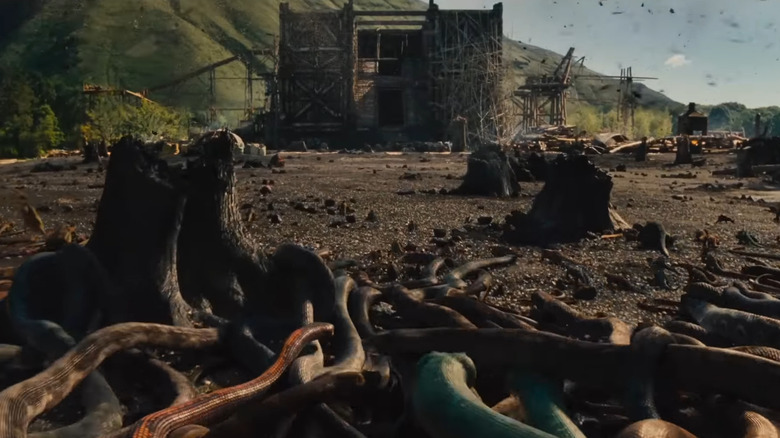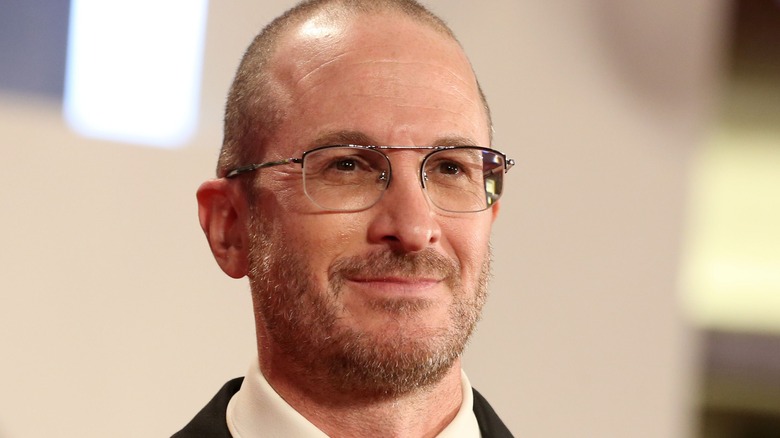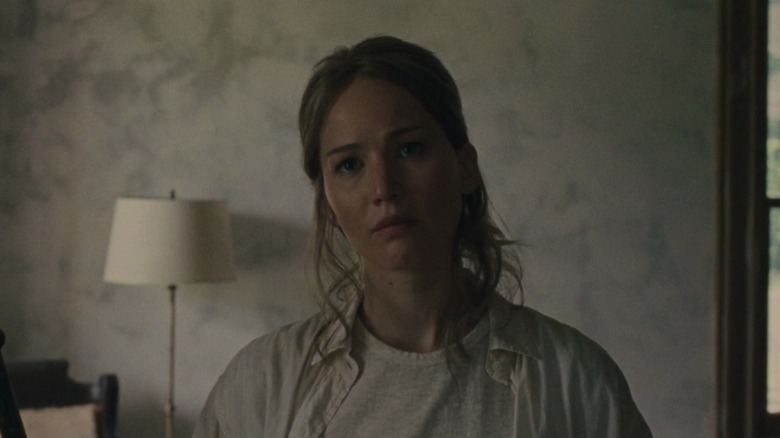The Untold Truth Of Darren Aronofsky
For decades, Darren Aronofsky has been creating films that get strong reactions from his audience. According to The Guardian, Aronofsky once told his father, "All I want in my life is for people to either cheer or boo. I just don't want anything in the middle." He's certainly achieved that goal.
Aronofsky's feature-length debut was 1998's "Pi," a black-and-white film about a mathematician slowly losing his mind as he searches for the numerical answer to everything. He followed that project up with "Requiem for a Dream," a visually disturbing examination of the power of addiction. Since then, Aronofsky has told stories set in wrestling rings and ballet studios, ranging from Biblical allegories to not-so-straightforward horror stories.
A film from Aronofsky isn't something an audience is likely to forget, either because it's haunting or just baffling. He's one of the most unique directors working in Hollywood, and he's proven time and again that he's truly committed to bringing his artistic visions to life. This is his untold truth.
Darren Aronofsky grew up admiring blockbusters
The films that directors fall in love with when they're young tend to have a big impact on the work they create as adults, so fans might expect that Darren Aronofsky grew up watching arthouse films and foreign cinema, but that just isn't the case. In many ways, the style that Aronofsky has become known for is as far from the media his younger self watched as possible.
"I grew up in the Spielberg–George Lucas era," Aronofsky told Time Magazine. The first films that left their mark on him were blockbusters like "Star Wars" and "E.T.," though as he got older, Aronofsky said, "Filmmakers like Spike Lee and Jim Jarmusch were big influences and expanded [my sense of] what film could be."
It wasn't just the big films and indie filmmakers of the day that influenced the way Aronofsky approached storytelling and his creative work. He also got to experience theatrical performances from time to time when his mother took him to see plays (via The Guardian). Aronofsky grew up on space epics and Broadway musicals, and their impact can be seen in his earlier work like "The Fountain" and more recent films like "The Whale," which is itself an adaptation of a 2012 play by Samuel D. Hunter.
Landing in film was 'arbitrary'
Darren Aronofsky may have grown up watching and loving film, but he didn't necessarily plan to become a filmmaker himself. After leaving high school, Aronofsky headed for Harvard, where he nearly ended up joining the fraternity that was famously depicted rejecting Mark Zuckerberg in David Fincher's "The Social Network" (via The Independent). Despite arriving at a major university, Aronofsky didn't have a clear sense of direction.
He told The Crimson that he started his collegiate career as a Sociology major before quickly realizing that wasn't the right path for him. He knew his interest in the arts was growing, but he wasn't ready to tell his parents about it just yet, so he switched majors to Social Anthropology. Aronofsky still hadn't landed on filmmaking, but he would soon. He applied for both sculpture and filmmaking classes, but only filmmaking accepted him. Almost instantly, he knew he'd found his place. "It was the first class that kept me awake at night," Aronofsky said, adding, "It was really arbitrary, but it's all arbitrary, I think, what you choose in life."
Aronofsky graduated from Harvard in 1991, but it would still be many years before his filmmaking career officially took off. After leaving university, Aronofsky went on to study at the American Film Institute before crafting his feature-length debut, "Pi" (via Indiewire). When that film premiered in 1998, Aronofsky's course was set.
His first film was made with $60,000
Darren Aronofsky's first feature-length film was a true indie success story. "Pi" follows Max Cohen, a mathematician who believes that numbers hold the key to understanding all of reality. Max's obsessive search for a numerical answer to everything slowly pulls his mind and life out of control.
Every once in a while, a small budget film like "The Blair Witch Project" manages to make an oversized splash, but for the most part, film budgets tend to balloon into hundreds of thousands or even millions of dollars. "Pi" — which won Aronofsky the best director award at 1998's Sundance Film Festival — was another story entirely.
In order to fund the film, Aronofsky and his partners turned to their friends, families, and acquaintances to ask for investments (via CNN). They asked everyone for $100 toward the project, with the promise that even if the movie didn't rake in the big bucks, anyone who pitched in would be given $150 down the road. Aronofsky told IndieWire that he and everyone else working on the film got to share in 50% of its profits, with the rest of the money going to pay back the original donors. Ultimately, they ended up raising $60,000 and created a massively impactful film that launched Aronofsky on a career that's now spanned over 30 years. Not bad for a first time, independently funded project.
His second film was rated NC-17
After releasing "Pi" in 1998, Darren Aronofsky began work on the project that cemented his place as a prominent director. 2000's "Requiem for a Dream" is an adaptation of a 1978 novel by Hubert Selby Jr. The film follows four characters who each struggle with their own addictions. Sara (Ellen Burstyn) becomes obsessed with taking amphetamine diet pills to control her weight, while her son Harry (Jared Leto) and his friends Tyrone (Marlon Wayans) and Marion (Jennifer Connelly) use and deal heroin. The film uses a variety of visual effects and camera techniques to try and embody the mindset of its main characters.
Before "Requiem for a Dream" even made its way to an audience, it was getting strong reactions. The MPAA gave the film an NC-17 rating ahead of its released, based primarily on the final three minutes of the film (via IndieWire). Aronofsky said he was dismayed by the MPAA's decision, but he argued that, "If I was to trim in any way that sequence — it's intensity — I think I would undermine the whole purpose of the movie." He said that he thought the rating would possibly bring more people out to see the film, particularly because no theaters passed on showing the film because of the rating. "Requiem for a Dream" ended up receiving glowing reviews from critics and general audiences, though some certainly agreed with the MPAA about the film's intensity.
He almost directed multiple comic book movies
It might be hard to imagine a director known for shocking arthouse cinema at the helm of a major superhero movie, but on more than one occasion, Darren Aronofsky has found himself in the position to oversee a comic book adaptation. Immediately after the success of "Requiem for a Dream," Warner Bros. approached Aronofsky about writing and directing the "Batman" reboot that would eventually go to Christopher Nolan (via New York Magazine). Aronofsky started work on the project, but his artistic dreams quickly pulled him away from it. "It was always all about 'The Fountain'," he said. As soon as the opportunity to make his dream film came around, he abandoned the superhero world.
Warner Bros. "Batman" reboot wasn't the only project that the studio hoped to give to Aronofsky. Years later his company Protozoa was given a first look at "The Wolverine" script written by Christopher McQuarrie (via The Hollywood Reporter). By that point, the director's life had changed significantly. He and actress Rachel Weisz had their son Henry in 2006, and Aronofsky's new priorities led him to turn down the film, which would've required him to work out of the country for nearly a year. Considering the pace at which superhero movies continue to be released, Aronofsky may get another chance to explore the medium.
The Fountain had a rough beginning
Often enough, filmmaking is a linear process from idea to script to studio, but some films take years to make and face unbelievable setbacks throughout the process. Darren Aronofsky had one of those complicated tales on his hands when he set out to make "The Fountain."
In an interview with New York Magazine, Aronofsky discussed his dreams for "The Fountain" and the heartbreaking experience he faced while making the film. Aronofsky had envisioned "The Fountain" as a sort of sci-fi epic, complete with stunning scenery and epic battle scenes. Brad Pitt read Aronofsky's script and loved what he found, so he signed on as the film's lead. Aronofsky spent two years developing his vision — which included filming in Australia, constructing a massive artificial pyramid, and hiring a crew of 450 people.
When it finally came time to begin filming in 2002, Aronofsky received a phone call informing him that Pitt had decided to leave the project to film "Troy" instead. Instead of flying to Australia to film his dream project, Aronofsky was going to pull the plug on the whole thing. The director said the experience was, "The worst day of my life."
Aronofsky never gave up on his dream, however. Years later, after paring down the script, he got Hugh Jackman to sign on as the lead, and in 2006, "The Fountain" made its way to theaters.
Darren Aronofsky hosted real wrestling matches
Almost everyone has heard about method acting, but what about method directing? Darren Aronofsky tends to go above and beyond for his films, like the level of inventive energy he brought to his 2008 movie "The Wrestler."
The film, which was nominated for two Oscars, stars Mickey Rourke as Randy "The Ram" Robinson. The Ram is a professional wrestler whose career has seen better days, and he's struggling to hold on to what he's always known while trying to find a new path for his future. When it came to embodying the wrestling lifestyle, Aronofsky and his crew really went above and beyond.
"We put on real live wrestling promotions and put on the matches," Aronofsky told Collider. In many of the film's key scenes, audiences aren't seeing elaborately built sets and paid extras. The rings, the audiences, and even the other wrestlers are all real, with Aronofsky saying, "My co-producer became a wrestling promoter to get it done." Shots of real-life matches were used in the film, but hosting the matches also inspired how the film's story ultimately came together. Near the end of the movie, Rourke's character gives a moving speech, and Aronofsky said it was based on a speech given by a real wrestler's family member at one of their events. Sometimes it pays to lean into realism instead of movie magic.
Black Swan was 10 years in the making
Whether you love or hate Darren Aronofsky's films, there's no denying that he's remarkably committed to his ideas and willing to stick with them for the long haul. By at least one metric, "Black Swan" is Aronofsky's most successful film — it earned him an Oscar nomination for best director — and its roots go back to the very beginning of his career.
Aronofsky told The Independent about when he had the first kernel of an idea for what would later become one of his best films. "When I graduated from film school, I made a list of possible worlds to set movies in, and one of them happened to be the wrestling world and one of them happened to be ballet." Andrés Heinz's script for a film called "The Understudy" about warring Broadway actresses landed on Aronofsky's desk years later, and he finally had his opportunity to make the film he'd been thinking about since his school days.
By the time Aronofsky was helping Heinz transform "The Understudy" to "Black Swan," he already had an actress in mind for the project. "I met with Natalie [Portman] eight or nine years ago," Aronofsky told Flicks and Bits shortly before the film's wide release. "We met in Times Square and had a coffee, and I had this idea for something set in the ballet world." They weren't able to start right away, but Aronofsky never gave up on the idea.
He said Noah was an odd choice
2014's "Noah" is a retelling of the Biblical flood story starring Russell Crowe, Jennifer Connelly, Anthony Hopkins, and Emma Watson. The film takes a decidedly fantastical approach to the story, incorporating mythical creatures and massive battle scenes into what's a fairly short tale from the Bible. According to Rotten Tomatoes, the film split opinions between critics who viewed it favorably and general audiences who wished they'd gone to see something else.
Darren Aronofsky told The Independent, "'Noah' is an odd choice for me, I admit." For one thing, religious-themed films are always risky ventures that have a strong chance of offending some audiences, and though Aronofsky was raised Jewish, he's not particularly religious himself. Aronofsky has an odd view of the Biblical story, and that might help to explain why he chose to film his own version of it. "I think Noah is the first superhero ... well, the second superhero. Adam and Eve are the first ones."
Though he clarified that the movie isn't a superhero film, the superhero framing is why Aronofsky wanted to explore Noah's story. For anyone who wanted to see Aronofsky's version of "Batman" or "The Wolverine," "Noah" is likely to make a sorry substitute, but on its own, the film is an interesting exploration of a very powerful human story.
He doesn't always understand his own films
Darren Aronofsky's films tend to be as baffling as they are beautiful. As a director, Aronofsky has an incredible sense of visual style, but his storytelling can sometimes be a little confusing or downright opaque. The ambiguity of films like "The Fountain" have inspired plenty of discussion among fans, but that same ambiguity can lead to poor reviews – it's hard to enjoy a film that can't be understood.
For anyone who's ever felt that Aronofsky must have a much deeper understanding of what he puts on the big screen than his prospective audience, rest assured, he's often just as confused. The director told Flicks and Bits that all the way back when "Pi" was first released, he learned that he doesn't fully understand his own work until he talks about it with other people. "I think the meaning changes as I speak about it and answer questions about it, and I see what you are all interested in." For Aronofsky, that's the real joy of being a filmmaker. He gets to use his ideas as a way to create meaning with the help of his audience. The approach isn't for everyone, but when it works, it can be something special.
He's a dedicated environmentalist
One of Darren Aronofsky's biggest concerns outside of filmmaking is the state of the environment and climate change, and he's found a way to use his film career to make a real impact in the world. "A big part of our mission at Protozoa," Aronofsky told IndieWire about his production company, "is to make films that talk about the environment and science while helping new filmmakers." That means that Aronofsky's company puts its weight behind environmentally minded projects like the series "One Strange Rock" and "Welcome to Earth" or documentaries like 2022's "The Territory." By supporting those projects, Aronofsky is able to assist small filmmakers while also raising awareness for environmental issues.
That same ethos affects how Aronofsky develops his own film projects too. He also told IndieWire that in his mind, "Noah" was intensely focused on the environment. "I was trying to point out that there's a story about environmentalism that's the fourth one in the Bible. ... I was trying to depoliticize it in whatever way I could." Aronofsky's films might not always have the effect he's hoping for, but he's committed to trying over and over again.
Darren Aronofsky's life isn't as dark as his movies
Many of Darren Aronofsky's movies take grim looks at the darker side of life. From the earliest days of his career, Aronofsky has been investigating addiction, violence, and the dangers of toxic relationships. "Write what you know" is commonly given advice for creators, but Aronofsky has actually worked in the opposite direction. His personal life and the lives in his films couldn't be more different.
"I hate violence!" Aronofsky told the Hindustan Times. He said that he tries to explore violence in his films as a way of showing people just how brutal and damaging it can be. Aronofsky's films are disturbing because he wants to be honest in his exploration of life's dark corners, and he almost has to explore those corners in film because he doesn't have the time to do it in real life.
"I'm a 9-to-5 father," Aronofsky told The Guardian. He and his ex-fiancée Rachel Weisz had a son in 2006, and fatherhood has consumed Aronofsky's off-the-clock time ever since. "I take my kid to school, go to sleep, live a life. Then go see my parents at weekends," he said. For a man known for creating incredibly disturbing and frequently upsetting films, Aronofsky himself leads a peaceful life.
mother! might be his most divisive film
In 2017, Darren Aronofsky released "mother!" ... and it may have become the most divisive film of his career. The film is psychological horror/home invasion story/bizarre parable of sorts starring Jennifer Lawrence and Javier Bardem. Critical opinions were mixed, but those who didn't appreciate the film were more than just disappointed. One reviewer wrote, "If this is Aronofsky's acknowledgement of those he's hurt in his life, then it is grossly remorseless." Another reviewer had a more nuanced take, writing, "No matter how downright revolting some of the imagery is, this is a very thoughtful film."
Aronofsky expected an intense reaction to the film. He told Hindustan Times, "We knew from the very beginning that we are being very attacking of the audience." Being antagonistic to your audience might not sound like a winning strategy, but Aronofsky has built his career on unorthodox strategies.
